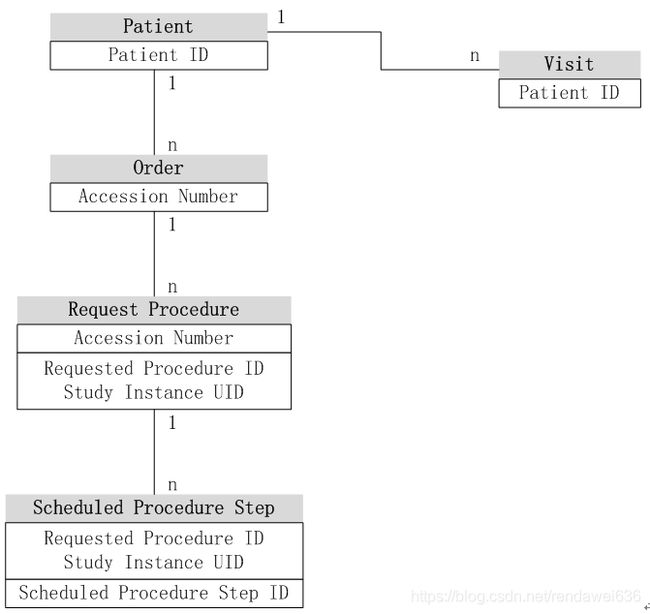云胶片(云影像)的接入 关键字段的理解
文章适合厂商系统工程师和院内信息科运维人员
1 标准概念
先讨论下DICOM和IHE 中的一些基础概念,
Accession Number 也叫流水号,在General Study Module中,是如下描述的Accession Number A RIS generated number that identifies the order for the Study.用来标示一个检查的送检单,这个号是由RIS生成。一定是标示送检单的。
我们再从IHE RAD中找到
Order: A request for an Imaging Service
Requested Procedure: Unit of work resulting in one report with associated codified, billable acts.
Scheduled and Performed Procedure Step: the smallest unit of work in the workflow that is scheduled (work to do) and/or performed (work done).
In the IHE Scheduled Workflow, the Accession Number identifies the Order. The requested Procedure ID distinguishes among Requested Procedures when an Order requires multiple Procedures. IHE sets a common meaning for these two terms to provide clinicians with a consistent and non-ambiguous access across different vendor products (RIS, PACS and Modalities).
Each Filler Order may contain one or more Requested Procedures. Each Requested Procedure is identified by a Requested Procedure ID that needs to be unique only within the scope of the Filler Order Number/Accession Number.
每个Order中包含一个或者多个Procedures,并且在每个用Accession Number标示的Order中,每个procedure都用Request Procedure Id来标示唯一。
A single Requested Procedure of one Procedure Type is the highest hierarchical unit of work level that may give rise to the creation of a report. Each report is one of the results produced to satisfy the order. For example, in a case of the order for an X-ray examination of a patient daily at 8 am for the next three days, each of the daily examinations will require a separate diagnostic report; hence each of them will be treated as a separate Requested Procedure. In order to support DICOM Query/Retrieve mechanism and easy collation of all results pertaining to a single procedure,Order Filler also generates the Study Instance UID, a globally unique identifier for each Requested Procedure. This identifier will be used to identify all generated images and other DICOM objects related to this Requested Procedure.
所以,我们从上边的描述中,可理解,一个Order包含1个或者多个Requested Procedure,每个Requested Procedure对应一份报告。例如,一个医生开出连续三天内,每天的8AM进行X线检查的送检单(Order),那么,每天一次的检查就是一个Requested Procedure,而且,每天都要针对检查出具独立的报告。那么,每个Order用Accession Number来标示,Requested Procedure用Requested Procedure ID来标示。另外,为了将此次检查的所有的结果,如报告、影像,和Requested Procedure产生关联,Order Filler角色还产生一个Study Instance UID,用这个UID将会用来标识所有的设备产生的图像和其他角色产生的DCM对象(例如gsps,报告,二次重建图像等)。
可以将这些关系,根据标准的一个关系图,绘制了一份相对简单的关系的实体结构图。
2 实际项目情况
上边是IHE对所有系统的流程的一个精确的定义,但实际项目中,由于很多厂商的工程师理解的差异,进而他们的程序流程也是不一致的。
首先,一个比较严重的问题就是RIS生成Study Instance UID,设备厂商不采纳问题,或者生成多个Study Instance UID,导致影像和Requested Procedure登记信息不匹配问题。
解决这个问题之前,我们先介绍下,Q/R工作原理。一般来说,设备工作站都定时的去按照时间段或者设备类型或者AETitle去RIS中查找任务,在查到的待检任务中,有个重要的信息Study Instance UID,也就是第一节中,用来标识和Requested Procedure对应影像的UID。基本上,所有的厂商都是这么做的。
但也有例外,如,万东核磁,完全不采纳RIS生成的Study Instance UID,自己生成一个其他的UID。但是,这个设备会使用Q\R中的Accession Number,也就是用来标识Order的号码。为了纠正这个错误,RIS可以将Request Procedure ID当做Accession Number格式发送给设备,后期,我们就可以用DCM中的Accession Number和Requested Procedure ID进行对比进行合并。
国外GPS三家设备相对规范。不过也有例外,在江西碰到一台版本比较老的飞利浦DR,这台设备,会在一个检查中,生成多个Study Instance UID,第一张图是正确的Study Instance UID,其他张数,就会自己生成不同的Study Instance UID号,通过对比DCM信息,发现只有Patient ID一直都没发生变化。所以,RIS将Request Procedure ID当做Patient ID,后期,通过DCM文件中的Patient ID和RIS的Request Procedure ID进行合并。
另外,国内很多小厂商,工作站的软件做的很没法形容,自动生成的ID号,会重复,例如贝斯达,发送PACS图像会无故失败;还有些小厂商设备生成的关键号,都是一个号,个人感觉这都是研发投入不够导致的所导致的。不过好在现在有写大厂崛起,迈瑞,联影,东软,安科,奥泰对接起来都还是很规范的,反正这个UI用来,无论设计上,还是操作上,都是有下了功夫的。
另外,还有一类错误是由"人祸"引起的,导致合并出现问题。例如,重拍、追加其他部位检查、急诊、夜诊,医师会直接在设备端登记操作,这样,设备上可能会生成多个或者不同的Study Instance UID,Patient ID和Accession Number,如果以上的DCM信息中关键Tag,都和之前登记信息不相同的话,就只能医生手动合并或者补录。如果有其他的信息一致,就可以通过其他信息方式进行合并。
所以,虽然在IHE中定义,Request Procedure ID、Study Instance UID都是和Request Procedure是一一对应的,一个Request Procedure对应写一份报告。但是,在实际的项目中,最严重的问题就是一个Request Procedure对应多个Study Instance UID的影像数据,这样,实际RIS中的静态表结构可以设计成如下静态结构。
3 合并策略
在院内PACS的场景中,如何获取HIS信息并且和设备的检查影像正确合并是一个很重要的设计内容,主要的设计思想也就是如何去适配各种设备厂商的影像设备,常规的可根据Study Instance UID合并,其他的方式可根据AETitle或者Modality将RIS生成的Requested Procedure ID替换成 Accession Number或者Patient ID,设备生成图像后,在反向规则合并。
这种场景应用方式,都是从PACS影像数据合并到RIS的登记信息上。目前,所有正规的PACS厂商也可以直接通过配置来完成。
但是,今天说重点是云胶片项目。云胶片项目基本上都是直接对接院内PACS系统的。需要收集三方面的信息,一是病人信息和报告信息,其次,是PACS的影像信息,最后是通过虚拟打印机截取打印的信息。一般来说,为了保证数据的完整性,最少应当接入1和2、2和3、或者1和2和3. 最好是1和2、1和2和3的组合方式。
一般对接的方式都是院内PACS开放一个视图,并且根据视图来CMOVE影像数据到云端。但是,当信息到达云端时,并不能保证视图信息一定比图像信息先到达。所以,这是需要解决将登记信息合并到图像信息上的问题。
另外,当虚拟打印机的信息也发送云端时,如何和原有的信息进行合并,也会有信息到达云端先后的问题,都是需要设计程序时,需要考虑的问题。

